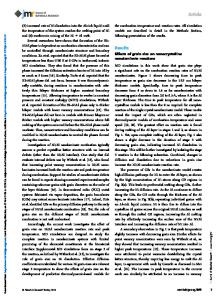Grain Size Effects in Plasma Cold-Hearth Withdrawal Melting
- PDF / 2,923,130 Bytes
- 9 Pages / 420.48 x 639 pts Page_size
- 74 Downloads / 314 Views
GRAIN SIZE EFFECTS IN PLASMA COLD-HEARTH WITHDRAWAL MELTING by M. E.
Schlienger, J. W. Sears and R. C. Eschenbach Retech, Inc., Ukiah, CA
ABSTRACT It has long been recognized that grain size has a marked effect on the subsequent processing characteristicsof metallic materials. Plasma cold hearth melting is a promising technique for the production of reactive and refractory metal ingots. A study has been conducted to determine the effect of melt parameters on the
subsequent grain size and shape in plasma cold hearth withdrawal of Ti-6AI-4V ingots. In the study, a number of ingots were made in
Retech's cold hqarth development furnace and sectioned for
examination. The relative importance of operating parameters such as surface heat distribution and flux and of stirring on grain size and shape are reported.
INTRODUCTION The use of plasma as a heat source for cold hearth melting has received much attention in the last few years. One of the original incentives was that it permitted using a wider range of feedstocks, in particular scrap.' The work showed that titanium scrap could be reprocessed effectively into electrodes which were suitable for VAR remelting. Subsequent work in a number of furnaces showed that plasma was good for maintaining alloy chemistry, and that by using hearth melting techniques, defects could be eliminated. 2 Currently, two production scale plasma melting furnaces for the titanium industry are being brought online. If plasma hearth melting is used as a final melt process, then grain size and orientation and surface finish become important, not just maintaining chemistry and eliminating inclusions. This study was undertaken to determine the effects of some of the operating conditions on grain size in plasma hearth melting. General 3considerations for cold-wall melting have recently been covered. A number of factcrs affect the quality of ingots made by withdrawal techniques in cold hearth melting. These include the heat input distribution and intensity on the top surface, the amount of stirring, if any, and movement of the ingot being withdrawn. A number of years ago, people doing electron beam hearth melting learned that periodic raising and lowering of the
Mat. Res. Soc. Symp. Proc. Vol. 190. @1991 Materials Research Society
46
withdrawal ingot could in some cases improve ingot surface. This is called "dither." Continuous casters for the steel industry are more elaborate, with mold walls which move. The casting rates for steel are such that the molten core extends much further into the ingot than it does in reactive metal casting. Work done with plasma showed that both dither and heat input pattern could affect the quality of the ingot. The effects of gas composition and 4 furnace pressure have been addressed elsewhere.
EQUIPMENT ARRANGEMENT Plasma Furnace Configuration The work was done in Retech's 1.8 meter plasma hearth furnace. This has been described previously. 5 Material feed, which for this test was compacts of titanium sponge blended with master alloy, each compact weighing ab
Data Loading...











